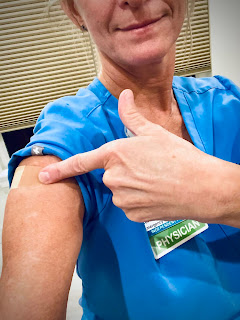Is this a real vaccine?
What follows is an explanation of how vaccines work, and how the mRNA vaccines in particular work, in what is (hopefully) friendly language. I was asked by a friend if I thought the COVID-19 vaccines really were in line with the traditional definition of vaccines, and I found myself producing what, in social media terms, would be considered a very lengthy response, but probably is pretty appropriate in blog terms.
Don't bail, please. It's user-friendly (and you ARE a user. We're talking use of the immune system here).
The human immune system is amazingly complex, and a semester college course can’t come anywhere near providing a full understanding of it, so I’ll be hard pressed to offer a full explanation here and now, but the nutshell is this:
When a foreign thing enters the body, whether it be bacteria, virus, or even food, a detection system is ready and waiting to determine if this thing is “self” or “not self.” Things that are “self” get a pass, but “not self” sets off alarms. In the case of a virus, these alarms trigger a cascade of reactions activating multiple parts of the immune system to eliminate the invader. These processes take time, which is why it takes up to several weeks to completely get over a cold. When your cold is gone, it is because your immune system mustered enough force to take it out. A key part of this response is the formation of “memory cells” that will recognize the invader if it ever returns, and activate the forces much more rapidly, and prevent it from ever taking hold. This is what we call immunity. The memory cells stimulate the production of antibodies - proteins that latch onto the invader and allow immune system cells to eat them up. These antibodies are specific to this particular invader, clinging to unique elements on its surface.
Vaccines are designed to prime the system and allow the production of these memory cells without actual infection having to take place. The first historical vaccination was performed when Edward Jenner injected a small amount of cowpox into a young boy - an amount lower than the amount needed to cause infection - but enough to stimulate the immune system to produce memory cells so that the body would recognize the similar smallpox when later exposed and mount a full on response at the get go. Future vaccines were developed using small parts of the infectious agent or inactivated organisms that couldn’t reproduce in the body to create the same response without the risk of infection.
So what’s different about the mRNA (messenger ribonucleic acid) vaccines? They invoke the same process, but go about things in a unique way, which is really quite ingenious. Instead of putting any fraction of the virus into the body, the vaccine introduces the genetic code that the cells can use to produce one important protein from the virus - in the case of SARS-COV-2 - the spike protein. This the the protein that allows the virus access to enter the cells and enables it to cause infection. After injection with the vaccination, the local cells take up the mRNA code and the machinery in your cells uses it to manufacture a supply of the spike protein. This protein is not the virus, cannot reproduce on its own, and can’t make you sick. The cells that make it send it out into the circulation, where immune cells recognize it as “not self” and start the cascade to develop memory cells that will activate if it is ever seen again. The mRNA, which makes up the vaccine, is rapidly degraded, as is the mRNA that your cells produce every second of your life by the billions for normal bodily functions. The spike proteins produced by the vaccine also are degraded, and the only remnants are the memory of it in your immune cells which will allow a rapid response in the event of future exposure.
Some people worry that, because we are talking about genetics here, that the vaccine will somehow alter their DNA. Without getting into an entire genetics course here (isn’t immunology enough?), I’ll say that mRNA does not enter the part of the cell (the nucleus) where the DNA is stored and has no influence at all on DNA. The only permanent alteration is that your immune system now has a ready response when it is faced with the SARS-COV-2 spike protein and can eliminate it from your system much faster, in most cases without letting it reproduce enough for you to experience symptoms or be able to pass it on to others.
The other ingredients of the mRNA vaccines are a lipid nanoparticle that your body easily breaks down, salt water, sugar, and a few other elements that are already in your body like potassium (no metals). Every ingredient is easily broken down by the body and is then gone.
I hope this helps. Sorry for being so wordy, but it's really hard to explain this stuff within social media character limits. In the end, you are, of course, free to choose as you will and take the chances you feel are the best for you and your family. I only try to advise and educate based on my own education and experiences, with hopes of improving the outcome for everyone.


Comments
Post a Comment